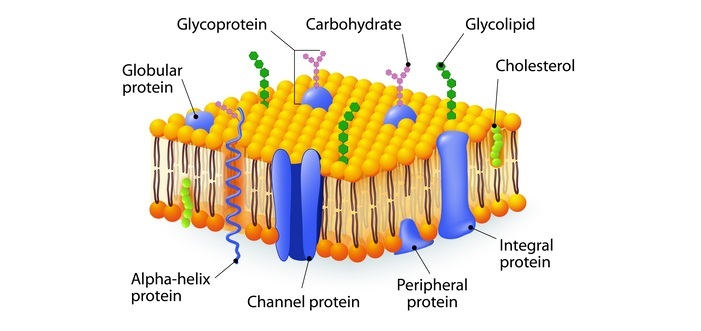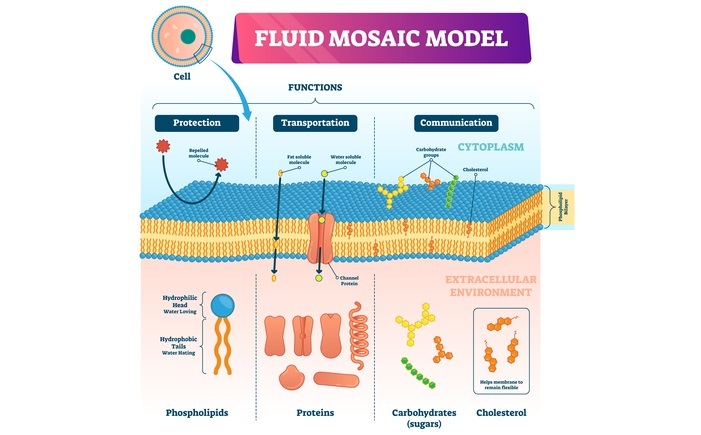
 Data Structure
Data Structure Networking
Networking RDBMS
RDBMS Operating System
Operating System Java
Java MS Excel
MS Excel iOS
iOS HTML
HTML CSS
CSS Android
Android Python
Python C Programming
C Programming C++
C++ C#
C# MongoDB
MongoDB MySQL
MySQL Javascript
Javascript PHP
PHP
- Selected Reading
- UPSC IAS Exams Notes
- Developer's Best Practices
- Questions and Answers
- Effective Resume Writing
- HR Interview Questions
- Computer Glossary
- Who is Who
Structure and Composition of Bio-membranes of a cell
Introduction and History
The membrane is an essential component of every living cell, which separates the cell from its external environment and provides a barrier to the free movement of molecules. The discovery of the cell membrane is attributed to the experiments of Robert Hooke and Anton van Leeuwenhoek in the seventeenth century, who first observed cells and bacteria under a microscope.

In the nineteenth century, researchers discovered that cells were surrounded by a thin layer of material, which later became known as the cell membrane.
The concept of the cell membrane's structure and composition began to take shape in the early twentieth century when E. Gorter and F. Grendel proposed the lipid bilayer model. Later, J. D. Robertson and J. E. Bangham developed a more detailed model, which is widely accepted today as the fluid-mosaic model.

Structure and Organization of Membranes
Biological membranes are composed of a lipid bilayer, which is a double layer of lipid molecules that provides a barrier to the free movement of molecules.
The lipid bilayer is composed of two layers of phospholipids, which are amphipathic molecules that have a hydrophilic head and a hydrophobic tail.
The phospholipids are arranged with their hydrophilic heads facing outwards towards the aqueous environment, and their hydrophobic tails facing inwards towards each other.
This creates a hydrophobic barrier that prevents the free movement of polar molecules, such as ions and sugars, across the membrane.
The lipid bilayer is also interspersed with proteins, which are embedded within the lipid bilayer or attached to its surface.
The proteins play various roles in the membrane's function, such as transport of molecules, signaling, and cell adhesion.
How Biological Membranes Are Made?
The biological membranes are made up of various types of lipids, proteins, and carbohydrates. The composition of the membrane varies depending on the cell type and its function.
The lipids in the membrane are mainly phospholipids, which are amphipathic molecules with a polar head and a nonpolar tail.

The phospholipids in the membrane are arranged in a bilayer with their polar heads facing outwards and their nonpolar tails facing inwards.
The nonpolar tails of the phospholipids are attracted to each other by hydrophobic interactions, which provides the membrane with its hydrophobic barrier.
The membrane proteins are embedded within the lipid bilayer or attached to its surface. The proteins are mainly responsible for the membrane's function, such as transport of molecules, signaling, and cell adhesion.
Functions of Biological Membranes
Cell Barrier
Biological membranes act as a barrier between the cell and its external environment, separating the inside of the cell from the outside. This barrier selectively allows the passage of certain molecules, such as nutrients and waste products, while preventing the entry of other molecules, such as toxins and pathogens.
Cell Signaling
Biological membranes contain proteins that act as receptors and channels for the transmission of chemical and electrical signals. These signals enable cells to communicate with each other and coordinate their activities, such as during development, immune responses, and nervous system functions.
Transport of Molecules
Biological membranes contain proteins that facilitate the transport of molecules across the membrane, such as ions, nutrients, and waste products. This process occurs through various mechanisms, such as passive diffusion, facilitated diffusion, and active transport.

Energy Production
Biological membranes are involved in energy production processes, such as photosynthesis in plants and cellular respiration in animals. The membranes of the chloroplasts and mitochondria are specifically adapted to facilitate the energy production processes in these organelles.
Cell Adhesion
Biological membranes contain proteins that enable cells to adhere to one another, forming tissues and organs. These proteins are essential for maintaining tissue architecture, such as in the skin, gut, and blood vessels.
Membrane Trafficking
Biological membranes play a crucial role in the intracellular transport of molecules and organelles. This process involves the fusion and fission of membranes and is vital for various cellular functions, such as protein secretion, vesicular transport, and endocytosis.
FAQs
Q1. What are the main components of biological membranes?
Ans. The main components of biological membranes are lipids, proteins, and carbohydrates.
Q2. How are biological membranes formed?
Ans. Biological membranes are formed through the self-assembly of lipids, which spontaneously arrange themselves into a bilayer structure.
Q3. What is the function of cholesterol in biological membranes?
Ans. Cholesterol helps to regulate the fluidity of biological membranes, making them more stable and less permeable to certain molecules.
Q4. What is the difference between a membrane protein and a peripheral protein?
Ans. A membrane protein is embedded in the lipid bilayer of the membrane, whereas a peripheral protein is only loosely attached to the surface of the membrane.
Q5. How do cells maintain the asymmetry of their biological membranes?
Ans. Cells use various mechanisms, such as lipid transport proteins and membrane enzymes, to maintain the asymmetry of their biological membranes.
Q6. What is the role of membrane transporters in biological membranes?
Ans. Membrane transporters facilitate the transport of molecules across biological membranes, such as ions, nutrients, and waste products.
Q7. What is the function of aquaporins in biological membranes?
Ans. Aquaporins are membrane proteins that facilitate the transport of water across biological membranes, allowing cells to maintain their water balance.
Q8. What is the role of the glycocalyx in biological membranes?
Ans. The glycocalyx is a layer of carbohydrates that covers the surface of biological membranes and is involved in various functions, such as cell adhesion, signaling, and protection.
Q9. What is the function of membrane rafts in biological membranes?
Ans. Membrane rafts are specialized regions of biological membranes that are enriched in certain lipids and proteins, and they play a role in various functions, such as cell signaling, membrane trafficking, and pathogen entry.

